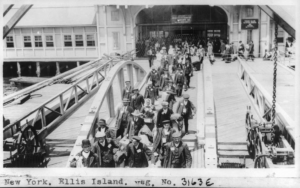In today’s world, the term “whiteness” has been demonstrated in explicit ways after the inception of the Trump administration. From KKK endorsements to Trump’s blatantly racist rhetoric and principles, from “building a wall” to keep Mexicans out of the United States to when the president failed to condemn the white nationalist groups by name who were behind the rally in Charlottesville, people of color who are struggling to enter the country are facing a great amount of adversity. Today, there is an encroaching fear of non-white individuals as a perceived threat to the “American people.” This shows that an exclusionary group of people takes precedence in this country: white, English-speaking Americans of Christian belief.

In the 19th century, many Europeans emigrated from their respective countries to seek out new opportunities in America.
Many Trump supporters are likely descendants of European immigrants. When they immigrated, these people were considered to be second-class citizens. However, the harsh treatment of European immigrants has largely receded from the public’s historical memory. The Irish, in particular, consisted of a large portion of European migrants in the 19th century. The study of Irish Diaspora with the use of archaeology can be used to understand their experiences with discrimination and assimilation in America (Brighton 2005) and how it translates into a fraction of the racial and nationalistic tension that exists today, which can contribute to discussions regarding “whiteness” in America.
One example of harsh treatment faced by Irish immigrants took place in South Bend, Indiana. Archaeological research done by Dr. Deborah Rotman reveals a considerable amount about the living conditions of the Irish in the 19th century. Some of the excavated findings from one family’s site included medicine bottles, indicating compromised access to medical facilities in the area, and tea ware, demonstrating a focus on preserving heritage rather than assimilating to American culture. As was supported by her team’s findings, Irish Catholics faced discrimination; they were associated with racially marginalized African-Americans. The Irish took up many jobs in unskilled labor in construction and factory work, placing them in competition with the black community in South Bend. Additionally, after the Civil War, there were heightened strains due to inequality and lack of economic prospects. Consequently, ethnic tensions and segregation in South Bend escalated in the following years (Rotman 2010).

In 1863, African-Americans were not considered citizens, so they were not allowed to be drafted in the Civil War, frustrating white workers dealing with inflation, food shortages, and unemployment. In general, European (mostly Irish) immigrants were tense with black workers who posed as a threat to their employment, and violence ensued.
As a result of the complicated history of estrangement for Irish immigrants (and other European migrants of the 19th century), which has affected their descendants, there is now a heightened sensitivity to other groups of people who could jeopardize the privilege they acquired after years of hardship. The establishment of a white American identity for these immigrants was a social development that occurred at the expense of people of color, especially those who threatened their livelihoods and employment—even to the point of implementing violence (e.g. the New York City Draft Riots of 1863 (Harris 2004)). The threat of a changing country exposes the fragility of white nationalism in recent times, and there has been significant backlash as a result.
Further Reading
https://splinternews.com/the-trump-administration-rejected-4-000-late-daca-renew-1820477468
Sources
Brighton, Stephen A. 2005. The Irish Diaspora and the Creation of an Irish-American Heritage. Center for Heritage Resource Studies. University of Maryland. http://www.heritage.umd.edu/chrsweb/Ireland/ireland.htm, accessed November 14, 2017.
Harris, Leslie M. 2004. In the Shadow of Slavery: African Americans in New York City, 1626-1863. Chicago, IL: University of Chicago Press.
Rotman, Deborah L. 2010. The Fighting Irish: Historical Archaeology of Nineteenth-Century Catholic Immigrant Experiences in South Bend, Indiana. Historical Archaeology 44(2): 113–131.
Rotman, Deborah L. 2015. The Beaver Island Project: Historical Archaeology of Nineteenth-Century Irish America in the Midwest. University of Notre Dame Blog Network. https://sites.nd.edu/irishstories/, accessed November 14, 2017.
Image Sources
Woodruff, Sheryl. 2011. On This Day: New York City Draft Riots. Web log. The Blog of the Greenwich Village Society for Historic Preservation. http://gvshp.org/blog/2011/07/13/on-this-day-new-york-city-draft-riots/, accessed November 14, 2017.

How does the finding of medical bottles in the excavation record show a compromised access to medical care?